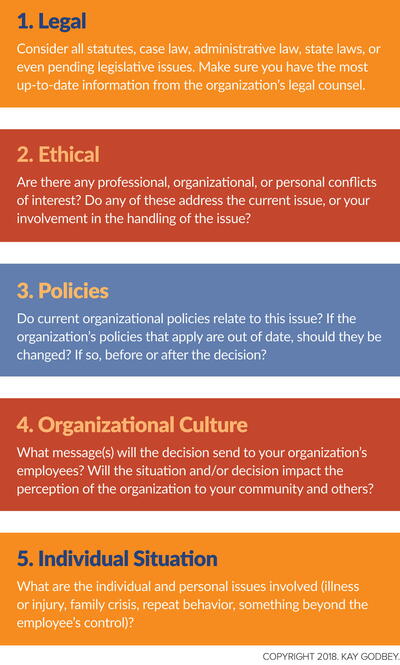
BY KAY GODBEY, PH.D.
Some of the most difficult and unpleasant tasks that managers, department heads, and supervisors must face are related to employee behavior. Those are also the issues that are often neglected, not dealt with in a timely manner, or not dealt with at all. Sometimes they have been going on for years and passed on for future managers to handle. They are time-consuming and stressful, and have the potential to do a great deal of damage to the workplace environment and the organization.
The Problem
Today, organizations have harassment and other laws to adhere to and human resource departments must keep up with these; however, interdepartmental managers and supervisors are often left out of the loop about legal aspects of employment law. Often, there is also a lack of knowledge and training in recognizing problems taking place or developing within the organization.
Human resource issues can impact the entire organization and reach out into the community. Some incidents draw media attention and appear on social media, complicating city management’s response. This, of course, can create additional stress for city management and others in the organization.
The most difficult of these issues can ultimately reach the city manager’s office. When a city manager is approached with a difficult, unresolved employee issue, tough decision-making is called for. These issues have the greatest potential for litigation and consume a great deal of staff and management’s time.
Recognizing and addressing inappropriate or other problem behavior in the workplace is a skill for which every person in the organization can benefit. Supervisors and managers especially need to know what to do when those activities are witnessed. Policies, procedures, and training for the actions needed should be written, updated, and distributed. We know this is true, but often are not able to keep up with the extra task of sharing valuable knowledge about the workplace environment. Such knowledge, however, can be of great help to supervisors and managers daily and ultimately when a decision must be made.
The Guide
The following simple guide can be of assistance. It covers the bases that should be considered, and if followed, can give confidence to management that a sound decision is being made for the information known at the time. It is helpful to all levels of management and supervision personnel as an educational tool for what they need to consider when they recognize that a workplace issue is at hand.

Keep the guide as a handy reference tool. Pay attention to the ranking hierarchy: (1) legal, (2) ethics, (3) policies, (4) organizational culture, and (5) the individual situation.
Legal is first because, above all, public organizations must operate on a solid legal footing. Organization legal staff and/or consulting attorneys should be included in this stage of the process.
Ethics come next. Organizations often have published employee ethics policies. Many public employee professions have their own ethics that may need to be considered. It’s wise to obtain a copy of any that may apply. Fortunately, ICMA and state municipal organizations have published ethics and guidelines that can be referenced, consulted with, and cited in the final written decision.
Policies of the organization may apply. However, consider if those policies are up to date or if they need to be changed. If you hear, “It’s the way we’ve always done it,” beware. In today’s rapidly changing world, such a mantra can be short-sighted and harmful to an organization. If an update is needed, consult with legal and human resource staff for consideration. Consider if changes should take place before or after the situation is concluded. Will training be needed for policy changes?
Organizational Culture is a big part of difficult decisions. Leadership ultimately creates organizational culture and a decision from the city manager’s office will influence this culture. Will the decision send a message that will improve the organization and uphold standards and ethics? If the decision is not communicated well, will it demoralize the organization? If so, can that impact be addressed through department meetings or other methods? Will the decision reach out into the community and impact the organization? If so, how will that be addressed, if at all? We know that many personnel issues have confidentiality issues, so legal staff may be needed when considering communication efforts.
The Individual Situation considered helps keep the element of humanity in the decision process. Each employee and their situation are unique. Here you may discover quite a spider’s web of issues. Is the employee having health, family, or financial problems? Do they have a family member in bad health that they are trying to care for? Sometimes things are beyond the employee’s control, but often it is the employee’s own behavior resulting in the need for action. Managers need to know all circumstances possible when making a final decision.
Application of the Guide
This guide has been part of a course that I teach that is a combination of academic and practitioner knowledge with mentoring elements woven in. The major assignment for the course is for each student to interview a city manager, deputy or assistant manager, human resource director, or department director regarding a difficult human resource issue they have dealt with in the past. Organizations and names are kept anonymous. The organization can be public, nonprofit, or private sector. Students write a report on the interview and apply the guide to the decision-making process. The students are at various levels within their public, nonprofit, and private organizations, and have found the guide helpful and have shared it with others. Sometimes they discover that the best decision is not the same decision a manager wishes they could make and may conflict with the manager’s own moral compass. That makes the manager’s job even more difficult and stressful. Future managers need to know this and be prepared for those feelings.
The guide can be useful for you, your organization, and the career path of city management hopefuls. It was created based on the practical decision-making process used during my own public service career. Even though it was not in writing during those years, its components were utilized by our organization’s management team as we faced many challenging issues. When I, as the city manager, had to make a final difficult and sometimes unpopular decision, the process gave me confidence that the best decision was made.
This guide may help, but it is certainly not the “rule” or the “one best way.” Always keep an open mind and look for creative solutions to those difficult human resource issues. That is what servant leaders do and that is how our organizations and communities improve.

KAY GODBEY, PH.D., is a retired city manager of Burleson, Texas; and an adjunct assistant professor at the University of Texas at Arlington (godbey99@yahoo.com).
New, Reduced Membership Dues
A new, reduced dues rate is available for CAOs/ACAOs, along with additional discounts for those in smaller communities, has been implemented. Learn more and be sure to join or renew today!
